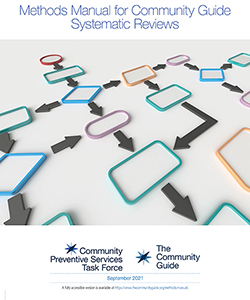Community Guide Methodology
The Community Preventive Services Task Force (CPSTF) issues recommendations and findings based on evidence from Community Guide systematic reviews. Community Guide methods are consistent, transparent, and scientifically rigorous. They account for the complexities of real-world public health interventions and are in accordance with the highest international standards.
Methods Manual for Community Guide Systematic Reviews
Learn about Community Guide systematic review methods that serve as the basis for CPSTF findings and access links to additional resources and published articles.
With guidance from CPSTF, coordination teams use a ten-step process to evaluate the effectiveness evidence for community-based programs, services, and policies aimed at improving population health. Economic review teams use a similar, nine-step process to evaluate the economic evidence for intervention approaches recommended by CPSTF. Economic reviews consider the cost of implementation, economic benefits, and estimates that compare cost-to-benefits or cost-to-health outcomes.
Effectiveness Evidence: Ten Steps in The Community Guide Systematic Review Process
- Select Topic: Select a review topic based on CPSTF prioritization
- Create Coordination Team: Create a team of staff, CDC program partners, CPSTF members, and other subject matter experts
- Select Intervention: Select an intervention within the topic
- Conceptualize: Define the intervention; craft the analytic framework; identify outcomes
- Search: Systematically search for and retrieve evidence
- Screen: Narrow retrieved set of papers
- Abstract: Evaluate studies for quality and collect information from papers
- Analyze: Analyze data from included studies
- Make CPSTF Recommendations: Translate evidence into CPSTF recommendations and findings
- Disseminate: Disseminate CPSTF findings and evidence gaps
Learn more about each step in The Systematic Review Methods Manual for The Community Guide — Part 1: Effectiveness Review Methods.
Economic Evidence: Nine Steps in The Community Guide Economic Systematic Review Process
- Prioritize Economic Review: Select reviews based on CPSTF prioritization
- Create Coordination Team: Create a team of staff, CDC program partners, CPSTF members, and other subject matter experts
- Conceptualize Economic Review: Define the intervention; craft the economic analytic framework; identify outcomes
- Search: Systematically search for and retrieve evidence
- Screen: Narrow retrieved set of papers
- Abstract: Evaluate studies for quality and collect information from papers
- Analyze: Analyze data from included studies
- Make CPSTF Economic Finding: Translate evidence into CPSTF economic findings
- Disseminate: Disseminate CPSTF findings and evidence gaps
Learn more about each step in The Systematic Review Methods Manual for The Community Guide — Part 2: Economic Review Process.
For More Information:
The Systematic Review Methods Manual for The Community Guide
Full-text articles about Community Guide methods
